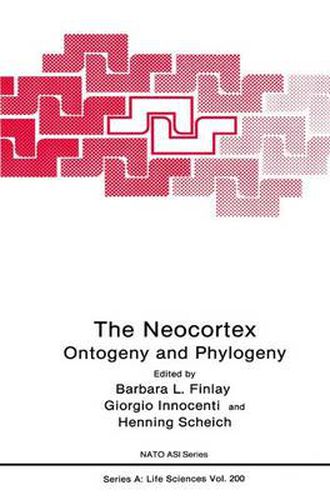Readings Newsletter
Become a Readings Member to make your shopping experience even easier.
Sign in or sign up for free!
You’re not far away from qualifying for FREE standard shipping within Australia
You’ve qualified for FREE standard shipping within Australia
The cart is loading…






This title is printed to order. This book may have been self-published. If so, we cannot guarantee the quality of the content. In the main most books will have gone through the editing process however some may not. We therefore suggest that you be aware of this before ordering this book. If in doubt check either the author or publisher’s details as we are unable to accept any returns unless they are faulty. Please contact us if you have any questions.
Of the three organizers of this NATO Advanced Research Workshop on Neocortex: Onto- geny and Phylogeny , one derived most of his knowledge about neocortex from studies on birds, another had never studied any animal but the cat and could probably recognize not more than ten animal species, and the third had very limited experience with mountaineering. They had in common the belief that evolutionary thinking permeates what biologists do, but that evolution of species and structures cannot be directly experimentally addressed. Although the fossil record can provide some major insights, the inroad to the evolution of the brain is indirect, via comparative anatomy and developmental biology. By identifying similarities and differences between brain structures in the species at hand, comparative anatomy generates hypotheses of evolutionary transformations. By understanding the rules of morphological transformation, developmental biology can, in principle, estimate the likelihood that a given transformation may have actually occurred. The meeting was a way to check if this notion is viable, by gathering together scientists from these two fields. Standing, left to right: F. Ebner, V. Caviness, M. Weisskopf, B. Fritszch, N. Swindale, J. Walter, H. Karten, J. Pettigrew, E. Welker, M. Cynader, D. Frost, L. Lopez-Mascaraque, P. Katz, H. Jerison, E. Soriano, Mayor of Alagna, Dr. G. Guglielmina, and associate, H. Van der Loos, B. Finlay, H. Scheich, C. Ruela. Seated: S. Pallas, T. Lohmann, J. De Carlos, F. Valverde, G. Innocenti, M. Diamond v Gathering does not accurately describe what really happened.
$9.00 standard shipping within Australia
FREE standard shipping within Australia for orders over $100.00
Express & International shipping calculated at checkout
This title is printed to order. This book may have been self-published. If so, we cannot guarantee the quality of the content. In the main most books will have gone through the editing process however some may not. We therefore suggest that you be aware of this before ordering this book. If in doubt check either the author or publisher’s details as we are unable to accept any returns unless they are faulty. Please contact us if you have any questions.
Of the three organizers of this NATO Advanced Research Workshop on Neocortex: Onto- geny and Phylogeny , one derived most of his knowledge about neocortex from studies on birds, another had never studied any animal but the cat and could probably recognize not more than ten animal species, and the third had very limited experience with mountaineering. They had in common the belief that evolutionary thinking permeates what biologists do, but that evolution of species and structures cannot be directly experimentally addressed. Although the fossil record can provide some major insights, the inroad to the evolution of the brain is indirect, via comparative anatomy and developmental biology. By identifying similarities and differences between brain structures in the species at hand, comparative anatomy generates hypotheses of evolutionary transformations. By understanding the rules of morphological transformation, developmental biology can, in principle, estimate the likelihood that a given transformation may have actually occurred. The meeting was a way to check if this notion is viable, by gathering together scientists from these two fields. Standing, left to right: F. Ebner, V. Caviness, M. Weisskopf, B. Fritszch, N. Swindale, J. Walter, H. Karten, J. Pettigrew, E. Welker, M. Cynader, D. Frost, L. Lopez-Mascaraque, P. Katz, H. Jerison, E. Soriano, Mayor of Alagna, Dr. G. Guglielmina, and associate, H. Van der Loos, B. Finlay, H. Scheich, C. Ruela. Seated: S. Pallas, T. Lohmann, J. De Carlos, F. Valverde, G. Innocenti, M. Diamond v Gathering does not accurately describe what really happened.